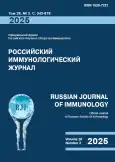Precultivation of cells subjected to long-term cryopreservation negatively affects proliferative activity of T lymphocytes
- 作者: Korolevskaya L.B.1, Shmagel K.V.1
-
隶属关系:
- Perm Federal Research Center, Ural Branch, Russian Academy of Sciences
- 期: 卷 28, 编号 3 (2025)
- 页面: 425-430
- 栏目: SHORT COMMUNICATIONS
- URL: https://journal-vniispk.ru/1028-7221/article/view/319881
- DOI: https://doi.org/10.46235/1028-7221-17125-POC
- ID: 319881
如何引用文章
全文:
详细
Peripheral blood mononuclear cells are a valuable biological material for most immunological studies. Cryopreservation of peripheral blood mononuclear cells provides access to large amounts of biomaterial at any time. Since cryopreservation can affect various cell parameters, several authors have proposed introducing a precultivation step for thawed cells to restore their functions. The aim of the study is to evaluate the effect of preculturing long-term cryopreserved cells on T lymphocyte proliferative capacity. Venous blood obtained from 18 relatively healthy volunteers who signed informed consent was used. Mononuclear leukocytes were isolated by centrifugation in a diacoll density gradient using a standard method. The resulting cells were subjected to controlled freezing at -80 °C for 24 hours before being transferred to liquid nitrogen. The duration of sample storage was 40±1.4 months. After thawing, the cells were divided into two parts; one part was immediately stained with 5(6)-carboxyfluorescein diacetate N-succinimidyl ester (CFSE), stimulated with phytohemagglutinin, and cultured in complete culture medium containing interleukin-2 for 7 days. The second part of the cells was precultivated in complete culture medium (18 hours) and then treated as described above. T lymphocyte proliferation was assessed by flow cytometry. It was found that the preculture stage did not affect the relative counts of proliferating T lymphocytes. However, the number of daughter generations formed by both CD4+ and CD8+T lymphocytes was reduced in samples with precultured cells. Additionally, a significant increase in the proportion of dying elements among dividing CD4+T cells was observed. This consequence of the preculture stage was not found in the pool of CD8+T lymphocytes. Thus, preculturing significantly increases the percentage of T lymphocytes dying during division. This phenomenon was only detected among CD4+T cells, which appears to reflect their greater sensitivity to in vitro death compared to CD8+T lymphocytes.
作者简介
Larisa Korolevskaya
Perm Federal Research Center, Ural Branch, Russian Academy of Sciences
编辑信件的主要联系方式.
Email: bioqueen@mail.ru
PhD (Medicine), Researcher, Laboratory of Ecological Immunology, Institute of Ecology and Genetics of Microorganisms
俄罗斯联邦, PermK. Shmagel
Perm Federal Research Center, Ural Branch, Russian Academy of Sciences
Email: bioqueen@mail.ru
PhD, MD (Medicine), Head, Laboratory of Ecological Immunology, Institute of Ecology and Genetics of Microorganisms
俄罗斯联邦, Perm参考
- Benczik M., Gaffen S.L. The interleukin (IL)-2 family cytokines: survival and proliferation signaling pathways in T lymphocytes. Immunol. Invest., 2004, Vol. 33, no. 2, pp. 109-142.
- Browne D.J., Miller C.M., Doolan D.L. Technical pitfalls when collecting, cryopreserving, thawing, and stimulating human T-cells. Front. Immunol., 2024, Vol. 15, 1382192. doi: 10.3389/fimmu.2024.1382192.
- Capelle C.M., Ciré S., Ammerlaan W., Konstantinou M., Balling R., Betsou F., Cosma A., Ollert M., Hefeng F.Q. Standard Peripheral blood mononuclear cell cryopreservation selectively decreases detection of nine clinically relevant T cell markers. Immunohorizons, 2021, Vol. 5, pp. 711-720.
- Li B., Yang C., Jia G., Liu Y., Wang N., Yang F., Su R., Shang Y., Han Y. Comprehensive evaluation of the effects of long-term cryopreservation on peripheral blood mononuclear cells using flow cytometry. BMC Immunol., 2022, Vol. 23, 30. doi: 10.1186/s12865-022-00505-4.
- Owen R.E., Sinclair E., Emu B., Heitman J.W., Hirschkorn D.F., Epling C.L., Tan Q.X., Custer B., Harris J.M., Jacobson M.A., McCune J.M., Martin J.N., Hecht F.M., Deeks S.G., Norris P.J. Loss of T cell responses following long-term cryopreservation. J. Immunol. Methods, 2007, Vol. 326, pp. 93-115.
- Santos R., Buying A., Sabri N., Yu J., Gringeri A., Bender J., Janetzki S., Pinilla C., Judkowski V.A. Improvement of IFNg ELISPOT performance following overnight resting of frozen PBMC samples confirmed through rigorous statistical analysis. Cells, 2014, Vol. 24, pp. 1-18.
- Sarkar S., Kalia V., Montelaro R.C. Caspase-mediated apoptosis and cell death of rhesus macaque CD4+ T-cells due to cryopreservation of peripheral blood mononuclear cells can be rescued by cytokine treatment after thawing. Cryobiology, 2003, Vol. 47, no. 1, pp. 44-58.
- Wang L., Hückelhoven A., Hong J., Jin N., Mani J., Chen B.A., Schmitt M., Schmitt A. Standardization of cryopreserved peripheral blood mononuclear cells through a resting process for clinical immunomonitoring – Development of an algorithm. Cytometry A, 2016, Vol. 89, pp. 246-258.
- Zhang J., Yin Z., Liang Z., Bai Y., Zhang T., Yang J., Li X., Xue L. Impacts of cryopreservation on phenotype and functionality of mononuclear cells in peripheral blood and ascites. J. Transl. Intern. Med., 2024, Vol. 12, no. 1, pp. 51-63.
补充文件









